dashboard warning lights FIAT DUCATO 2012 Owner handbook (in English)
[x] Cancel search | Manufacturer: FIAT, Model Year: 2012, Model line: DUCATO, Model: FIAT DUCATO 2012Pages: 287, PDF Size: 4.5 MB
Page 94 of 287

90
KNOWING
YOUR CAR
SAFETY
STARTING
AND
DRIVING
WARNING
LIGHTS AND
MESSAGES
IN AN
EMERGENCY
MAINTENANCE
AND CARE
TECHNICAL
SPECIFICATIONS
INDEX
DESK/BOOKREST fig. 100
(for versions/markets where provided)
There is a desk A in the middle of the dashboard above
the sound system compartment; on some versions this
desk can be used as a bookrest by raising the back
section and resting it on the dashboard as illustrated in
the figure.
On versions with passenger side air bags, the desk is
fixed.
Do not use the desk in a vertical position
with the vehicle in motion.
WARNING
SHELF ABOVE THE CAB fig. 101
(for versions/markets where provided)
This is located above the driver’s cab and is designed to
store light objects.
Maximum permitted load:
– localised .........................................................................10 kg
– distributed over the entire surface of the shelf ....20 kg
F0N0058mfig. 100F0N0190mfig. 101
Page 95 of 287

91
KNOWING
YOUR CAR
SAFETY
STARTING
AND
DRIVING
WARNING
LIGHTS AND
MESSAGES
IN AN
EMERGENCY
MAINTENANCE
AND CARE
TECHNICAL
SPECIFICATIONS
INDEX
CAB GLOVE COMPARTMENT fig. 102
(for versions/markets where provided)
The storage compartment is fitted above the sun visors
and is designed for the quick storage of light objects
(e.g. documents, road maps etc.).
FLAP ON BENCH fig. 103
(for versions/markets where provided)
To use, the pull tab A and lower the flap.
The flap is equipped with two cup holders and a support
surface with a paper holder clip.
SATELLITE NAVIGATOR CAPABILITY fig. 104
(for versions/markets where provided)
This is located in the dashboard area illustrated in the
diagram for connecting the navigator.
F0N0191mfig. 102
F0N0149mfig. 103
F0N0512mfig. 104
Portable navigators to be fitted in the seat
in figure 104 have a mechanical release
device activated by pressing the two side
buttons on the stem. The failed operation of the
release may damage the seat of the navigator.
Page 102 of 287
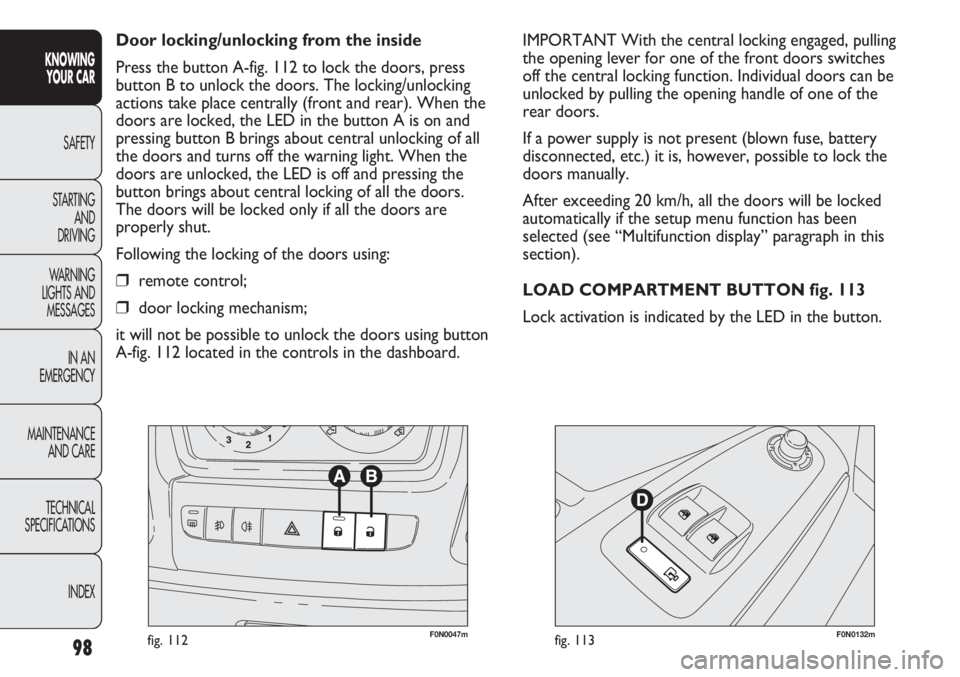
98
KNOWING
YOUR CAR
SAFETY
STARTING
AND
DRIVING
WARNING
LIGHTS AND
MESSAGES
IN AN
EMERGENCY
MAINTENANCE
AND CARE
TECHNICAL
SPECIFICATIONS
INDEX
F0N0047mfig. 112F0N0132mfig. 113
IMPORTANT With the central locking engaged, pulling
the opening lever for one of the front doors switches
off the central locking function. Individual doors can be
unlocked by pulling the opening handle of one of the
rear doors.
If a power supply is not present (blown fuse, battery
disconnected, etc.) it is, however, possible to lock the
doors manually.
After exceeding 20 km/h, all the doors will be locked
automatically if the setup menu function has been
selected (see “Multifunction display” paragraph in this
section).
LOAD COMPARTMENT BUTTON fig. 113
Lock activation is indicated by the LED in the button. Door locking/unlocking from the inside
Press the button A-fig. 112 to lock the doors, press
button B to unlock the doors. The locking/unlocking
actions take place centrally (front and rear). When the
doors are locked, the LED in the button A is on and
pressing button B brings about central unlocking of all
the doors and turns off the warning light. When the
doors are unlocked, the LED is off and pressing the
button brings about central locking of all the doors.
The doors will be locked only if all the doors are
properly shut.
Following the locking of the doors using:
❒remote control;
❒door locking mechanism;
it will not be possible to unlock the doors using button
A-fig. 112 located in the controls in the dashboard.
Page 103 of 287
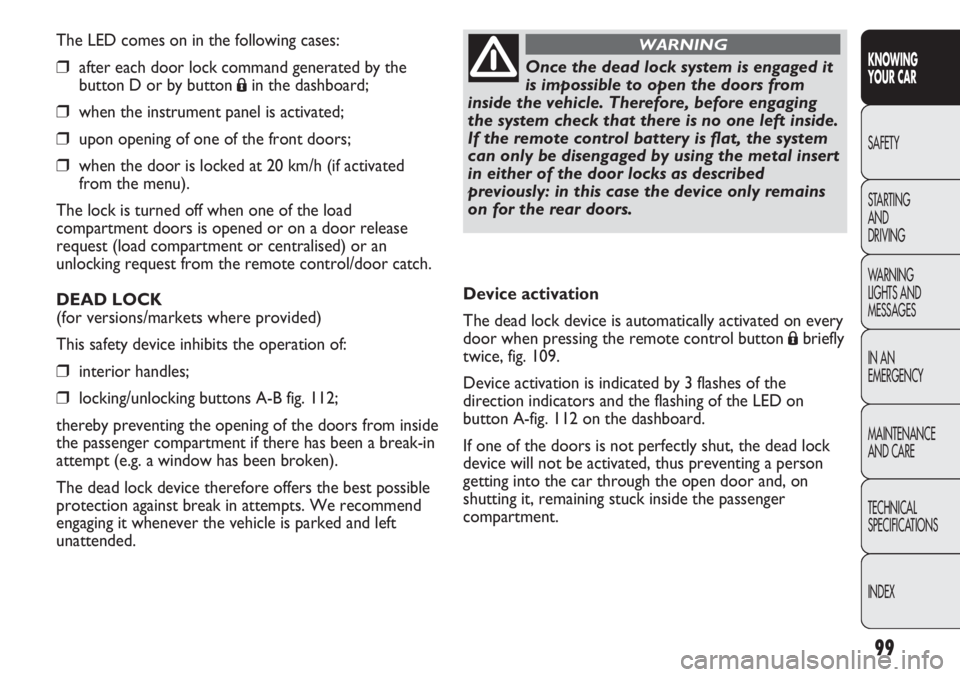
99
KNOWING
YOUR CAR
SAFETY
STARTING
AND
DRIVING
WARNING
LIGHTS AND
MESSAGES
IN AN
EMERGENCY
MAINTENANCE
AND CARE
TECHNICAL
SPECIFICATIONS
INDEX
The LED comes on in the following cases:
❒after each door lock command generated by the
button D or by button
Áin the dashboard;
❒when the instrument panel is activated;
❒upon opening of one of the front doors;
❒when the door is locked at 20 km/h (if activated
from the menu).
The lock is turned off when one of the load
compartment doors is opened or on a door release
request (load compartment or centralised) or an
unlocking request from the remote control/door catch.
DEAD LOCK
(for versions/markets where provided)
This safety device inhibits the operation of:
❒interior handles;
❒locking/unlocking buttons A-B fig. 112;
thereby preventing the opening of the doors from inside
the passenger compartment if there has been a break-in
attempt (e.g. a window has been broken).
The dead lock device therefore offers the best possible
protection against break in attempts. We recommend
engaging it whenever the vehicle is parked and left
unattended.
Once the dead lock system is engaged it
is impossible to open the doors from
inside the vehicle. Therefore, before engaging
the system check that there is no one left inside.
If the remote control battery is flat, the system
can only be disengaged by using the metal insert
in either of the door locks as described
previously: in this case the device only remains
on for the rear doors.
WARNING
Device activation
The dead lock device is automatically activated on every
door when pressing the remote control button
Ábriefly
twice, fig. 109.
Device activation is indicated by 3 flashes of the
direction indicators and the flashing of the LED on
button A-fig. 112 on the dashboard.
If one of the doors is not perfectly shut, the dead lock
device will not be activated, thus preventing a person
getting into the car through the open door and, on
shutting it, remaining stuck inside the passenger
compartment.
Page 117 of 287
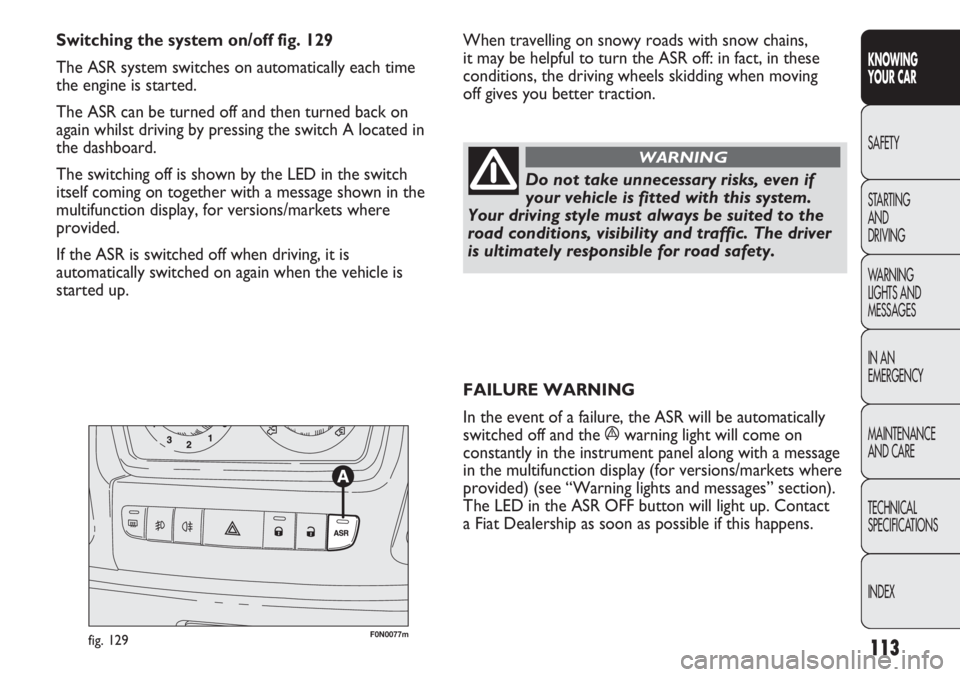
113
KNOWING
YOUR CAR
SAFETY
STARTING
AND
DRIVING
WARNING
LIGHTS AND
MESSAGES
IN AN
EMERGENCY
MAINTENANCE
AND CARE
TECHNICAL
SPECIFICATIONS
INDEX
FAILURE WARNING
In the event of a failure, the ASR will be automatically
switched off and the áwarning light will come on
constantly in the instrument panel along with a message
in the multifunction display (for versions/markets where
provided) (see “Warning lights and messages” section).
The LED in the ASR OFF button will light up. Contact
a Fiat Dealership as soon as possible if this happens. Switching the system on/off fig. 129
The ASR system switches on automatically each time
the engine is started.
The ASR can be turned off and then turned back on
again whilst driving by pressing the switch A located in
the dashboard.
The switching off is shown by the LED in the switch
itself coming on together with a message shown in the
multifunction display, for versions/markets where
provided.
If the ASR is switched off when driving, it is
automatically switched on again when the vehicle is
started up.
F0N0077mfig. 129
Do not take unnecessary risks, even if
your vehicle is fitted with this system.
Your driving style must always be suited to the
road conditions, visibility and traffic. The driver
is ultimately responsible for road safety.
WARNING
When travelling on snowy roads with snow chains,
it may be helpful to turn the ASR off: in fact, in these
conditions, the driving wheels skidding when moving
off gives you better traction.
Page 118 of 287
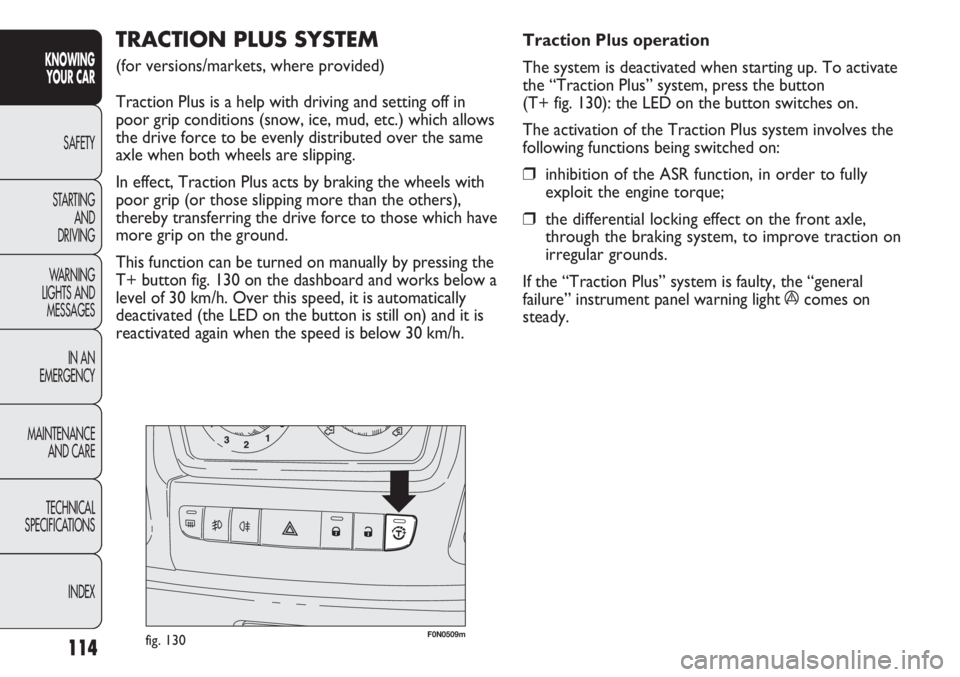
114
KNOWING
YOUR CAR
SAFETY
STARTING
AND
DRIVING
WARNING
LIGHTS AND
MESSAGES
IN AN
EMERGENCY
MAINTENANCE
AND CARE
TECHNICAL
SPECIFICATIONS
INDEX
TRACTION PLUS SYSTEM
(for versions/markets, where provided)
Traction Plus is a help with driving and setting off in
poor grip conditions (snow, ice, mud, etc.) which allows
the drive force to be evenly distributed over the same
axle when both wheels are slipping.
In effect, Traction Plus acts by braking the wheels with
poor grip (or those slipping more than the others),
thereby transferring the drive force to those which have
more grip on the ground.
This function can be turned on manually by pressing the
T+ button fig. 130 on the dashboard and works below a
level of 30 km/h. Over this speed, it is automatically
deactivated (the LED on the button is still on) and it is
reactivated again when the speed is below 30 km/h.Traction Plus operation
The system is deactivated when starting up. To activate
the “Traction Plus” system, press the button
(T+ fig. 130): the LED on the button switches on.
The activation of the Traction Plus system involves the
following functions being switched on:
❒inhibition of the ASR function, in order to fully
exploit the engine torque;
❒the differential locking effect on the front axle,
through the braking system, to improve traction on
irregular grounds.
If the “Traction Plus” system is faulty, the “general
failure” instrument panel warning light ácomes on
steady.
F0N0509mfig. 130
Page 134 of 287
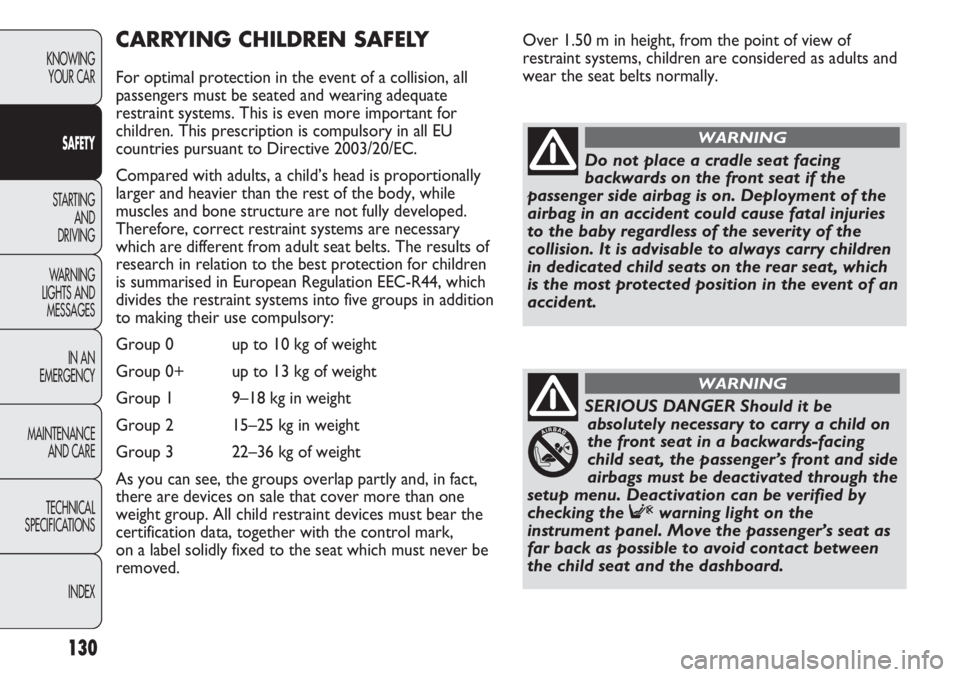
Over 1.50 m in height, from the point of view of
restraint systems, children are considered as adults and
wear the seat belts normally.
130
KNOWING
YOUR CAR
SAFETY
STARTING
AND
DRIVING
WARNING
LIGHTS AND
MESSAGES
IN AN
EMERGENCY
MAINTENANCE
AND CARE
TECHNICAL
SPECIFICATIONS
INDEX
CARRYING CHILDREN SAFELY
For optimal protection in the event of a collision, all
passengers must be seated and wearing adequate
restraint systems. This is even more important for
children. This prescription is compulsory in all EU
countries pursuant to Directive 2003/20/EC.
Compared with adults, a child’s head is proportionally
larger and heavier than the rest of the body, while
muscles and bone structure are not fully developed.
Therefore, correct restraint systems are necessary
which are different from adult seat belts. The results of
research in relation to the best protection for children
is summarised in European Regulation EEC-R44, which
divides the restraint systems into five groups in addition
to making their use compulsory:
Group 0 up to 10 kg of weight
Group 0+ up to 13 kg of weight
Group 1 9–18 kg in weight
Group 2 15–25 kg in weight
Group 3 22–36 kg of weight
As you can see, the groups overlap partly and, in fact,
there are devices on sale that cover more than one
weight group. All child restraint devices must bear the
certification data, together with the control mark,
on a label solidly fixed to the seat which must never be
removed.
Do not place a cradle seat facing
backwards on the front seat if the
passenger side airbag is on. Deployment of the
airbag in an accident could cause fatal injuries
to the baby regardless of the severity of the
collision. It is advisable to always carry children
in dedicated child seats on the rear seat, which
is the most protected position in the event of an
accident.
WARNING
SERIOUS DANGER Should it be
absolutely necessary to carry a child on
the front seat in a backwards-facing
child seat, the passenger’s front and side
airbags must be deactivated through the
setup menu. Deactivation can be verified by
checking the Fwarning light on the
instrument panel. Move the passenger’s seat as
far back as possible to avoid contact between
the child seat and the dashboard.
WARNING
Page 141 of 287
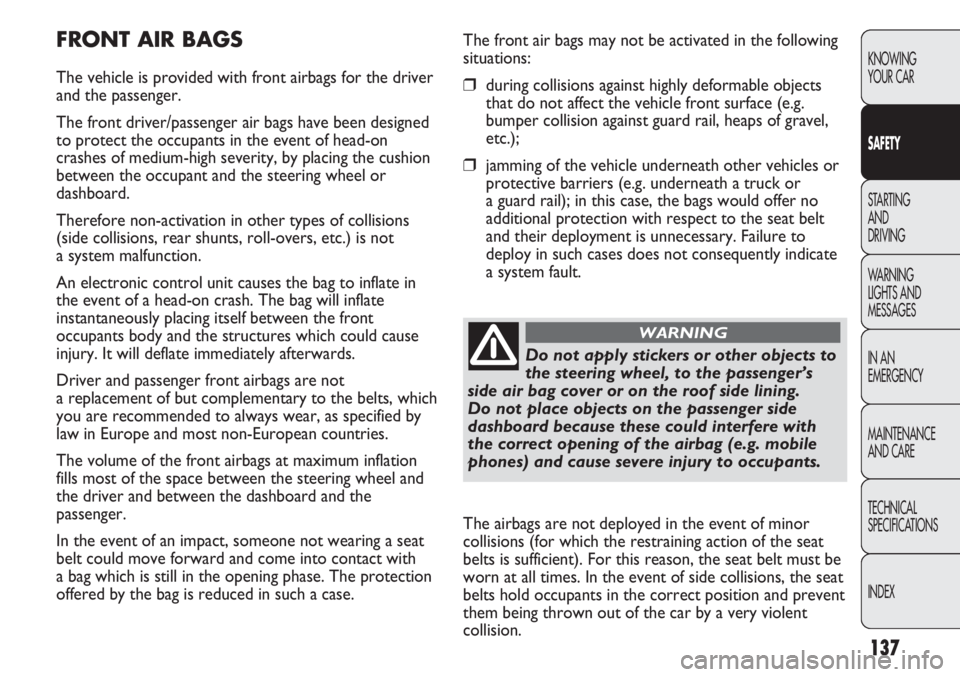
137
KNOWING
YOUR CAR
SAFETY
STARTING
AND
DRIVING
WARNING
LIGHTS AND
MESSAGES
IN AN
EMERGENCY
MAINTENANCE
AND CARE
TECHNICAL
SPECIFICATIONS
INDEX
The front air bags may not be activated in the following
situations:
❒during collisions against highly deformable objects
that do not affect the vehicle front surface (e.g.
bumper collision against guard rail, heaps of gravel,
etc.);
❒jamming of the vehicle underneath other vehicles or
protective barriers (e.g. underneath a truck or
a guard rail); in this case, the bags would offer no
additional protection with respect to the seat belt
and their deployment is unnecessary. Failure to
deploy in such cases does not consequently indicate
a system fault.
FRONT AIR BAGS
The vehicle is provided with front airbags for the driver
and the passenger.
The front driver/passenger air bags have been designed
to protect the occupants in the event of head-on
crashes of medium-high severity, by placing the cushion
between the occupant and the steering wheel or
dashboard.
Therefore non-activation in other types of collisions
(side collisions, rear shunts, roll-overs, etc.) is not
a system malfunction.
An electronic control unit causes the bag to inflate in
the event of a head-on crash. The bag will inflate
instantaneously placing itself between the front
occupants body and the structures which could cause
injury. It will deflate immediately afterwards.
Driver and passenger front airbags are not
a replacement of but complementary to the belts, which
you are recommended to always wear, as specified by
law in Europe and most non-European countries.
The volume of the front airbags at maximum inflation
fills most of the space between the steering wheel and
the driver and between the dashboard and the
passenger.
In the event of an impact, someone not wearing a seat
belt could move forward and come into contact with
a bag which is still in the opening phase. The protection
offered by the bag is reduced in such a case.
Do not apply stickers or other objects to
the steering wheel, to the passenger’s
side air bag cover or on the roof side lining.
Do not place objects on the passenger side
dashboard because these could interfere with
the correct opening of the airbag (e.g. mobile
phones) and cause severe injury to occupants.
WARNING
The airbags are not deployed in the event of minor
collisions (for which the restraining action of the seat
belts is sufficient). For this reason, the seat belt must be
worn at all times. In the event of side collisions, the seat
belts hold occupants in the correct position and prevent
them being thrown out of the car by a very violent
collision.
Page 142 of 287
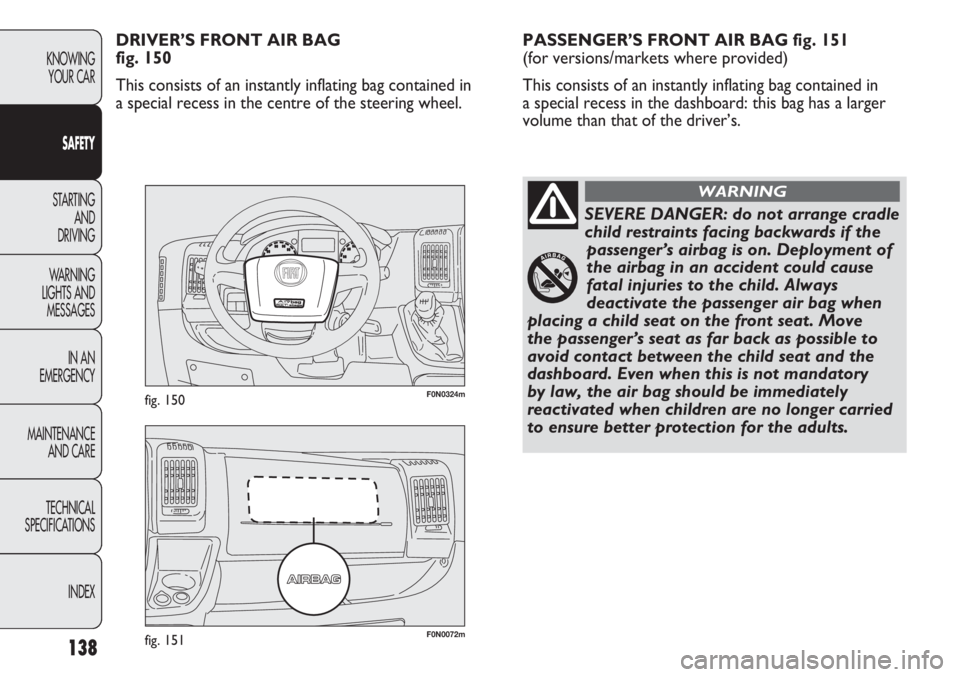
138
KNOWING
YOUR CAR
SAFETY
STARTING
AND
DRIVING
WARNING
LIGHTS AND
MESSAGES
IN AN
EMERGENCY
MAINTENANCE
AND CARE
TECHNICAL
SPECIFICATIONS
INDEX
F0N0072mfig. 151
F0N0324mfig. 150
PASSENGER’S FRONT AIR BAG fig. 151
(for versions/markets where provided)
This consists of an instantly inflating bag contained in
a special recess in the dashboard: this bag has a larger
volume than that of the driver’s. DRIVER’S FRONT AIR BAG
fig. 150
This consists of an instantly inflating bag contained in
a special recess in the centre of the steering wheel.
SEVERE DANGER: do not arrange cradle
child restraints facing backwards if the
passenger’s airbag is on. Deployment of
the airbag in an accident could cause
fatal injuries to the child. Always
deactivate the passenger air bag when
placing a child seat on the front seat. Move
the passenger’s seat as far back as possible to
avoid contact between the child seat and the
dashboard. Even when this is not mandatory
by law, the air bag should be immediately
reactivated when children are no longer carried
to ensure better protection for the adults.
WARNING
Page 143 of 287
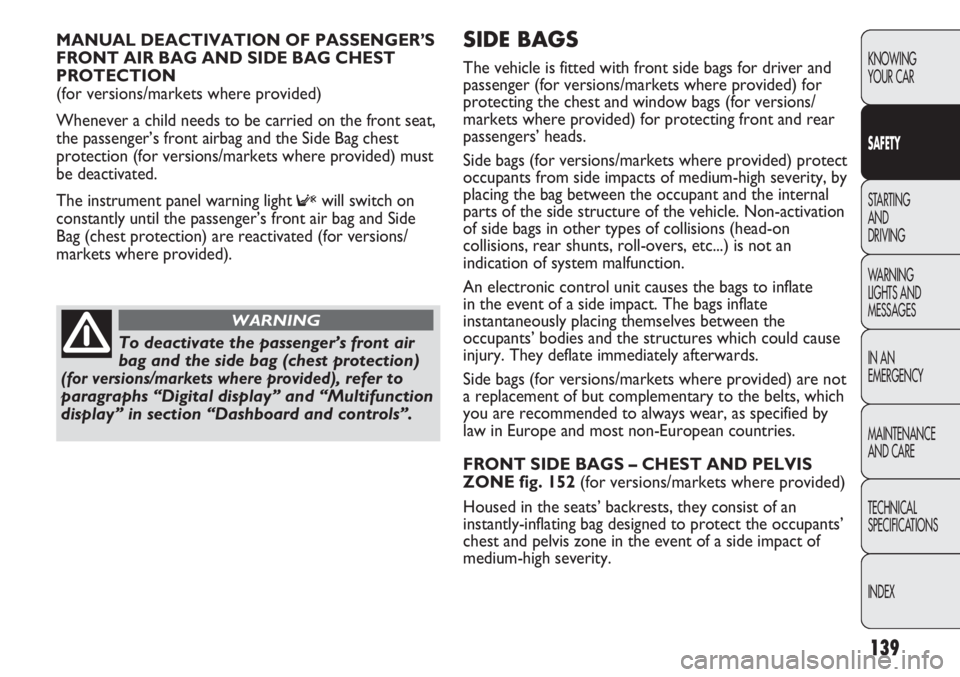
139
KNOWING
YOUR CAR
SAFETY
STARTING
AND
DRIVING
WARNING
LIGHTS AND
MESSAGES
IN AN
EMERGENCY
MAINTENANCE
AND CARE
TECHNICAL
SPECIFICATIONS
INDEX
SIDE BAGS
The vehicle is fitted with front side bags for driver and
passenger (for versions/markets where provided) for
protecting the chest and window bags (for versions/
markets where provided) for protecting front and rear
passengers’ heads.
Side bags (for versions/markets where provided) protect
occupants from side impacts of medium-high severity, by
placing the bag between the occupant and the internal
parts of the side structure of the vehicle. Non-activation
of side bags in other types of collisions (head-on
collisions, rear shunts, roll-overs, etc...) is not an
indication of system malfunction.
An electronic control unit causes the bags to inflate
in the event of a side impact. The bags inflate
instantaneously placing themselves between the
occupants’ bodies and the structures which could cause
injury. They deflate immediately afterwards.
Side bags (for versions/markets where provided) are not
a replacement of but complementary to the belts, which
you are recommended to always wear, as specified by
law in Europe and most non-European countries.
FRONT SIDE BAGS – CHEST AND PELVIS
ZONE fig. 152 (for versions/markets where provided)
Housed in the seats’ backrests, they consist of an
instantly-inflating bag designed to protect the occupants’
chest and pelvis zone in the event of a side impact of
medium-high severity. MANUAL DEACTIVATION OF PASSENGER’S
FRONT AIR BAG AND SIDE BAG CHEST
PROTECTION
(for versions/markets where provided)
Whenever a child needs to be carried on the front seat,
the passenger’s front airbag and the Side Bag chest
protection (for versions/markets where provided) must
be deactivated.
The instrument panel warning light
Fwill switch on
constantly until the passenger’s front air bag and Side
Bag (chest protection) are reactivated (for versions/
markets where provided).
To deactivate the passenger’s front air
bag and the side bag (chest protection)
(for versions/markets where provided), refer to
paragraphs “Digital display” and “Multifunction
display” in section “Dashboard and controls”.
WARNING